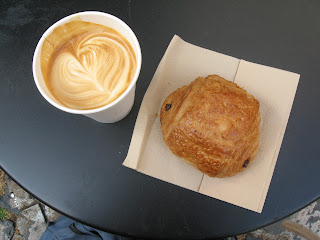I recently noticed something both curious and delightful during my thrice-weekly commute to Berkeley via Montgomery Street.
(For those unacquainted with the Authoress’s current whereabouts, the Lady of Quality has of since departed from the UK and now resides next to a strip club in a particularly libertine quarter of North Beach, San Francisco.)
But I digress. Taking notice of the immanent opening of this Coffee-Bar made me realize how urban rhythms are so often dictated by patterns of taste, connoisseurship, and, of course, caffeine addiction. When I was working at the Westminster City Archives back in August, for example, it was always a delight to conclude my commute at Old Pye Street, where I would down a deliciously decadent flat white before spending the rest of the day monotonously scrolling through parish soup-house records on microfilm. (I mean, with a name like this, how could one not expect to find something appetizing?)
 |
| At Old Pye Street: Perking up to study paupers |
I’m not sure if this San Francisco Coffee-Bar will offer flat whites (an Australian concoction of creamy espresso infused goodness). Nevertheless, I find it very probable that this establishment will soon be incorporated into my morning commute.
Indeed, urban topographies are inflected by thousands of minute decisions having to do with our culinary preferences and how far we are willing to walk for them. But to what extent did this hold true in 18th century London? Judging from this map below of the City, it seems like little has changed.
19 coffee houses concentrated in about 3 blocks? That’s a tough act to follow, even for 21st century San Francisco. But it shows us how savvy coffee shop proprietors were quick to set up shop wherever they could expect to profit from the sustained pedestrian traffic of financiers and merchants, who were equally eager for the caffeine fix and the exchange of information. Not only were coffee-houses intimately associated with financial institutions, but every so often, they became the financial institutions themselves. Jonathan's (number 9 on the map above) grew into the London Stock Exchange, and Lloyd's (number 17) became the insurance company that still exists today.
 |
| At last: Flat Whites at NEAT |
Post-Script- For those of my Readers, who, having managed to get through this post, are now desirious of a flat white, I finally managed to order one at NEAT Cafe in Darien, CT. (And, in case the photo to the right isn't enough to whet your appetite, it was so good that it even managed to sway my generally caffeine-averse companion.) Next time any of my readers happen to find themselves in Fairfield County, it is most certainly worthy of a detour.


I am most interested in your post on coffee houses, but was saddened to note that the map was not displaying properly. Thank-you for enlightening me regarding English tastes. It is proving most helpful in my research of 18th century foodways.
ReplyDeleteOh no ... that was the best part of the post!! Hopefully I can fix that soon.
ReplyDelete